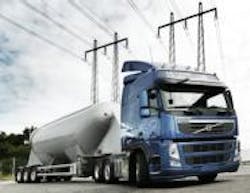“We’ve chosen a route whereby we combine the diesel engine’s superior efficiency rating with the benefits of liquefied methane gas, resulting in a truck that is significantly more energy-efficient than traditional [natural] gas trucks.” –Mats Franzén, manager of engine strategy and planning, Volvo Trucks
For a while now, Sweden’s Volvo Trucks has tinkered with highway tractors powered by a blend of 75% liquefied methane gas and 25% diesel. Now the truck maker is taking its experiment a step further – putting three of its FM-model highway tractors powered by this unique alternative fuel in the hands of European fleets to see how it works in the real world.
These FM-model tractors are equipped with Euro 5 complaint 460 hp 13-liter engines modified to run on this liquefied methane/diesel cocktail. The trucks also feature Volvo’s I-Shift automatic transmission as well, the OEM said.
Lars Mårtensson, environmental director at Volvo Trucks, noted that this liquefied methane/diesel propulsion method is “a revolutionary step” in the development of so-called “biogas” use in heavy vehicles, since trucks running on liquid methane combined with diesel technology offers up to four times longer driving range compared to most traditional natural gas trucks.
He added that if methane gas is cooled down to minus 160 celsius instead of being compressed, it becomes liquid and its volume is reduced by half. In this case, it is called LNG (liquefied natural gas), or LBG (liquefied biogas) if it is a biogas; though both of these gases are also called LMG (liquefied methane gas).
[Volvo showed off is LMG/diesel truck at the recent Hannover trade show in Germany.]
The key, though, explained Mats Franzén, manager of engine strategy and planning at Volvo Trucks, is range. When liquid methane and diesel are used in a ratio of 75% and 25%, respectively, a truck performing long haul or intercity duties has an operating range 500 to 1,000 kilometers, depending on driving conditions.
“And, until the infrastructure for liquid methane gas has been fully expanded, it is also a great advantage for trucks powered by methane diesel engines to be able to run on diesel alone,” Franzén pointed out.
Volvo said its field test vehicles are being operated by three transport companies: DHL, Götene Kyltransporter and Renova.
The start of these field tests coincides (not surprisingly) with the inauguration of Sweden's first public filling station for LMG, at Stigs Center in Göteborg. The station is a collaborative project between Volvo Trucks, Fordonsgas Sverige and Göteborg Energi, the OEM noted.
Three filling stations for liquefied methane gas have been planned in Sweden to date. Besides the completed one in Göteborg, Aga will open a filling station in Stockholm, and Eon will open one in Malmö, with Volvo Trucks as a partner in all the projects. Obviously, the truck maker said, there are plans to build additional stations if demand increases.
Now, is this a “silver bullet” to transportation’s heavy reliance on petroleum for fuel? Nope, not by a long shot. But it does offer a chance at significant reductions in pure diesel consumption while also giving fleets a “safety net” of sorts. For, like Volvo’s Franzén said, if one of these trucks runs out of LMG, it can always operate purely on diesel.
There’s also the “environmental benefit” to consider, especially when it comes to carbon dioxide (CO2) emissions, which is becoming the big bug-a-boo in government regulatory circles these days.
“Increased use of gas is a bridge towards climate-neutral transports,” said Volvo’s Mårtensson. “We believe we’re currently in a transition period, moving from decades of dependence on oil to a society built on renewable fuels. When trucks can operate on 80% pure biogas and 20% pure biodiesel, carbon emissions will be 80% lower than with conventional diesel technology.”
Volvo’s field tests will help determine if the transportation sector can reach such an end game.
